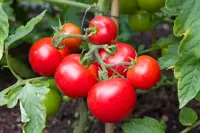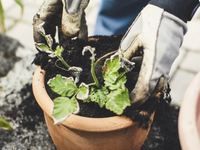
Tomatoes are one of the most versatile and beloved ingredients in the kitchen. Whether sliced for sandwiches, chopped for salads, or used in cooking, their juicy sweetness and bright colour make them a staple in many households. But what many people may not realise is that tomatoes are actually a type of fruit, not a vegetable!
In this guide, we will cover the different types of tomatoes including cherry tomatoes, normal tomatoes, red tomatoes, and yellow tomatoes. We will also discuss the ideal time to plant, the perfect soil for growing healthy tomatoes, and provide a step-by-step guide to sowing tomato seeds. Finally, we will offer expert tips for caring for your tomato plants to ensure a successful harvest. Let’s get started!
The health benefits of home-grown tomatoes
Tomatoes are a popular and versatile fruit that offer numerous health benefits. Growing your own tomatoes is a great way to enjoy fresh and nutritious ingredients in your kitchen.
When it comes to growing tomatoes, it's important to understand the difference between fruits and vegetables. Tomatoes are a fruit and are high in vitamins C and K, potassium, and lycopene. Vitamin C is essential for a healthy immune system, while potassium helps regulate blood pressure and fluid balance. Lycopene is a powerful antioxidant that has been linked to a reduced risk of heart disease, certain cancers, and other health conditions. In addition, tomatoes are low in calories and high in fibre, making them a great choice for anyone looking to maintain a healthy weight.
Tips for the best home-grown tomatoes
If you’re interested in growing your own tomatoes, it is important to choose the right variety for your climate and soil type. In the UK, the best time to plant tomatoes is in late spring or early summer, when the weather is warm and sunny. Tomatoes prefer well-drained soil that is rich in organic matter, and they also need plenty of sunlight to thrive. Regular care and attention, such as watering, feeding, pruning, and protecting from pests and diseases, are important for a successful harvest.
Tomatoes can be grown both indoors and outdoors. The UK climate can be variable, and conditions such as rain, wind, and cold temperatures can damage or slow the growth of tomatoes. If you are growing tomatoes in a greenhouse or under cloches, you can protect your plants from adverse weather conditions and extend the growing season.
The number of tomato seeds you need to grow your own tomatoes will depend on several factors, including the size of your garden, the number of plants you want to grow, and the germination rate of the seeds. As a general guideline, you can expect about 50-75% of tomato seeds to germinate and grow into healthy plants, so it's a good idea to plant 2-3 times the number of seeds you actually want to grow.
For a small garden or container, you may only need a few seeds, while for a larger garden, you may need several dozen seeds. If you are new to gardening or have limited space, it may be best to start with a few seeds and see how many plants you actually need based on your personal growing conditions and needs.
How to grow your own tomatoes?
To grow tomatoes, you will need the following materials:
- Tomato seeds or seedlings
- Potting soil
- Pots or garden bed
- Water
- Sunlight
And here’s how you go about it:
- Choose a location that gets at least 6 hours of direct sunlight per day.
- Prepare your pots or garden bed by adding potting soil and making sure they have proper drainage.
- Plant your seeds or seedlings, making sure to space them evenly and to bury the roots deeply enough to support the plants as they grow.
- Water your plants regularly, making sure the soil stays consistently moist but not waterlogged.
- Make sure the plants receive enough sunlight, and provide support such as a tomato cage or stakes to keep the plants upright as they grow.
- Fertilise your plants regularly with a balanced tomato fertiliser to support healthy growth and fruit production.
- Harvest your tomatoes when they are fully ripe and enjoy them fresh or cook with them as desired.
With proper care, you can expect to harvest tomatoes in about 2-3 months after planting.
Which are the most popular tomato varieties to grow yourself?
When it comes to choosing tomatoes for your garden or for the grocery store, there are many options to choose from. Cherry tomatoes are a type of small, round tomato that are typically 1-2 inches in diameter. They are sweeter and more flavourful than larger tomatoes, and are often used in salads, as a snack, or as a garnish. Normal tomatoes, on the other hand, are larger and come in a range of shapes and sizes, from the round Roma tomato to the oblong Beefsteak tomato. They are typically used in a wider variety of dishes than cherry tomatoes, and are often sliced for sandwiches, chopped for salads, or used in cooking.
The following tomato varieties are widely popular and well-known for growing in home gardens:
- Roma: A medium-sized tomato that is ideal for making sauces and paste.
- Cherry: A small, sweet tomato that is perfect for snacking and adding to salads.
- Beefsteak: A large, juicy tomato that is perfect for slicing and adding to sandwiches and salads.
- San Marzano: An Italian variety that is ideal for making sauces and paste.
- Big Boy: A large, juicy tomato that is perfect for slicing and adding to sandwiches and salads.
- Early Girl: An early-maturing variety that produces medium-sized tomatoes that are ideal for slicing and eating fresh.
- Brandywine: An heirloom variety that is prized for its rich, sweet flavour and juicy flesh.
These are just a few of the many popular and well-known tomato varieties that are well suited for growing in home gardens. When choosing tomato varieties, consider your local climate, the size of your garden, and your personal taste preferences.
Which tomato varieties can you grow in your garden in the UK?
In the UK, you can grow a wide range of tomato varieties in your garden, including some all-time favourites:
- San Marzano: An Italian variety that is ideal for making sauces and paste.
- Beefsteak: A large, juicy tomato that is perfect for slicing and adding to sandwiches and salads.
- Ailsa Craig: An early variety, ideal for cooler climates.
- Gardeners' Delight: A sweet cherry tomato that is easy to grow and popular with gardeners.
- Sungold: A popular cherry tomato known for its sweet flavour and high yield.
- Tumbling Tom: A compact cherry tomato that is perfect for growing in hanging baskets or pots.
These are just a few of the many tomato varieties that you can grow in the UK. When choosing varieties, consider your local climate, the size of your garden, and your personal taste preferences.
How long does it take to grow your own tomatoes?
You can choose to plant tomato seeds indoors from late winter to early spring, and then move them outdoors when the risk of frost has passed, typically in late May or early June.
The exact timing for planting and harvesting will depend on your local climate, the tomato variety you are growing, and the intended use of the fruit. For example, some early-maturing tomato varieties can be harvested in just 10-12 weeks from transplanting, while others may take up to 16 weeks or more.
When planting tomato seeds indoors, you can expect them to germinate in 7-14 days, and then they will need several weeks to grow into sturdy seedlings before they are ready to be transplanted into the garden.
Good to know: Harvesting of tomatoes usually begins in late summer and continues into early autumn, with the exact timing depending on the variety and growing conditions. Tomatoes are typically harvested when they are fully ripe and have reached their peak of flavour and nutrition. You can determine if a tomato is ready to be picked by gently squeezing it; it should give slightly but not be too soft.
Growing your own tomatoes, or any other fruit or vegetables, is a great way to enjoy fresh, nutritious, and delicious ingredients in your kitchen. The activity itself can be experienced as relaxing and rewarding. With the right knowledge and care, you can have a successful harvest of ripe and juicy tomatoes.




